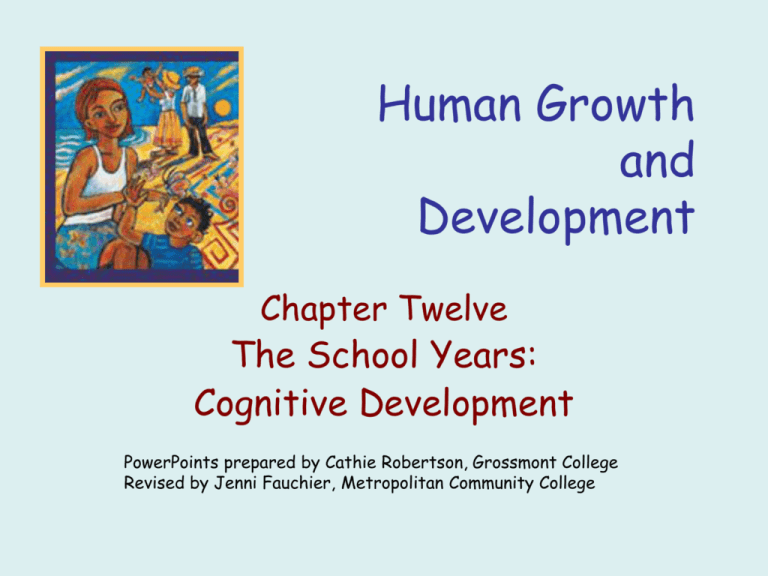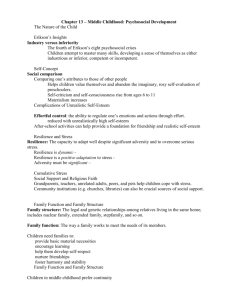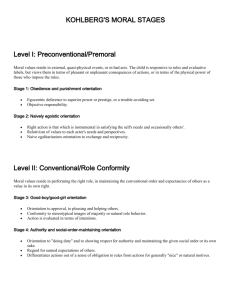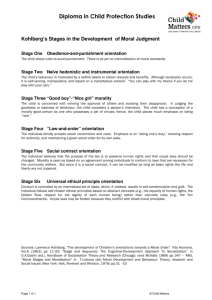Cognitive - Metropolitan Community College
advertisement

Human Growth and Development Chapter Twelve The School Years: Cognitive Development PowerPoints prepared by Cathie Robertson, Grossmont College Revised by Jenni Fauchier, Metropolitan Community College Building on Piaget and Vygotsky • Concrete Operational Thought – Piaget’s 3rd stage – children reason logically about the things and events that they perceive • Vygotsky did not believe the child was a socially isolated learner – instruction by others is crucial Logical Principles • • • • Classification Identity Reversibility Reciprocity • Classifying Objects, Ideas, and People – Classification—process of organizing things into groups according to some shared property – Children have an understanding categories can be any of the following: • hierarchical • overlapping • separate – Children that can categorize can analyze problems, derive correct solutions, and ask follow-up questions • Identity, Reversibility, and Reciprocity – identity—the idea that certain characteristics of an object remain the same even if other characteristics change – reversibility—the idea that sometimes an object that has been changed can be returned to its original state by reversing the process by which it was changed – Reciprocity occurs when 2 things change in opposite ways in order to balance each other out; e.g., conservation experiment with liquid • Identity, Reversibility, and Reciprocity – all three concepts are relevant to mathematical processes – these concepts can be (but are not always) applied to everyday social encounters Logic and Culture • Piaget’s ideas still remain logical – research shows that sometimes older children may make mistakes when applying new logic • Vygotsky’s premise is that, added to Piaget’s ideas, the social cultural context of learning is important • Most research in U.S. and England – but in Brazil, research has shown that street children who do not attend school can still think in complex ways, and that a special relationship exists between thinking and experience Moral Development • Focus is on Kohlberg’s theory – built on Piaget’s theory and research, theory describes moral developmental stages Kohlberg’s Stages • Kohlberg studied responses of subjects presented with ethical dilemmas to see – how a person reasons determine stage of moral development Kohlberg’s Stages, cont. • Kohlberg found 3 levels of moral reasoning • I. Preconventional: Middle Childhood – these first 2 stages of moral thinking relate to preoperational thought, in being egocentric • emphasis on getting rewards and avoiding punishment Kohlberg’s Stages, cont. • II. Conventional: End of Middle Childhood, Beginning of Adolescence -these 2 stages relate to concrete operational thought, in referencing observable practices in community • emphasis on social rules Kohlberg’s Stages, cont. • III. Postconventional : Adolescence and Adulthood – these 2 stages similar to formal or postformal thought, which includes ideas and ideals • emphasis on moral principles Kolhberg’s Critics • Kohlberg’s basic scheme has been replicated, but his ideas have been widely criticized • Three Major Criticisms – flawed research methods – hierarchy biased in favor of Western elite – moral development of women ignored Kohlberg’s Critics, cont. • Criticism 1: Methodology: To avoid Kohlberg’s cumbersome methodology, James Rest devised Defining Issues Test (DTI)— a questionnaire that measures moral thinking by asking people to read various dilemmas and then rank 12 statements as possible resolutions for each statement - DIT confirms validity of Kohlberg’s three levels Kohlberg’s Critics, cont. • Criticism 2: Cultural Differences - research suggests that in non-Western cultures, preeminent values are different from western ones, making it harder for nonWesterners to score at Kolberg’s preconventional level - research suggests that Kohlberg’s hierarchy may underestimate reasoning capacity of some school-age children in some cultures Kohlberg’s Critics, cont. • Criticism 3: Gender Issues • Carol Gilligan (1982) – females develop more of a morality of care—a reluctance to judge right and wrong in absolute terms because they are socialized to be nurturant, compassionate, nonjudgmental – males develop more of a morality of justice—a tendency to emphasize justice over compassion, judging right and wrong in absolute terms Information Processing • Piaget’s and Vygotsky’s theories in relation to moral development – both recognize ages 7 to 11 are time for moral growth – children eager to develop moral values in stages (Kohlberg, inspired by Piaget) – or in response to cultural norms (Vygotsky and Gilligan) Information Processing • Information Processing Theory - processes by which the mind • analyses • stores • retrieves • Mind is like a computer - capacity can be upgraded with development Memory • Sensory memory aka sensory register—stores incoming stimulus for split second then sends it on – sensations become perceptions • Working (short-term) memory— where your current, conscious mental activity occurs • Long-term memory—stores information for minutes, hours, days, months, years Speed of Processing • Older children are quicker thinkers than younger children • Thinking speed continues to increase throughout adolescence • Automatization helps free up thoughts for speed of processing Knowledge Base • Knowledge base—broad body of knowledge in a particular subject area that makes it easier to master new learning in that area • Connections between bits of information improve as the knowledge base expands Control Processes • Control processes—regulate the analysis and flow of information within the system – helped by maturation of prefrontal cortex Selective Attention • Selective attention—ability to concentrate on relevant information and disregard distractions • Memory and thought depend on this ability - focusing on what needs to be remembered • Improved control – emotional regulation shows it Metacognition • “Thinking about one’s thoughts” • Older children approach cognitive tasks more strategically and analytically The Pragmatics of Language • Pragmatics—using language fluently in many types of situations; from play through school years, distinguished by – logic – memory – ability to make connections between one bit of knowledge and another Teaching and Learning • Worldwide, many ideological debates swirl around the content and practice of elementary education • A review of practices in 5 cultures found – discrepancy between “expressed claim and observed reality” Which Curriculum? • Intended curriculum—content political and educational leaders decide to endorse • Implemented curriculum—what teachers and school administrators actually offer • Attained curriculum—what students actually learn Which Curriculum, cont. • Hidden curriculum—unspoken and often unrecognized lessons children learn in school – organization and schedule arise from hidden curriculum • e.g., classroom size The Reading Wars • Phonics • Whole language • “Reading Wars”—clashes over these two methods of teaching children to read Phonics Versus Whole Language • Phonics approach—teaching reading by requiring children to learn the sounds of each letter before they begin to decipher simple words Phonics Versus Whole Language, cont. • Whole-language approach—teaching reading by encouraging children to develop all their language skills— talking and listening, reading and writing—all with the goal of communication The Socioeconomic Divide • Language development, reading attainment correlate with socioeconomic status – the lower the family income, the less developed a child’s vocabulary and grammar • Crucial factor seems to be actual exposure to language (children exposed to language at home will have larger vocabularies) • vocabulary size the best predictor of school achievement and overall intelligence The Math Wars • Math and science are key areas in which children should be ready for the challenges of the future – gains in U.S. have faded • Traditionally taught through rote learning – children came to hate math taught this way The Math Wars, cont. • New curriculum developed that teaches – concepts, problem solving, estimating, and probability – this approach may be working • proportion of 4th graders who were “proficient” doubled (26%) The Math Wars, cont. • Technology is another area of controversy – Specifically, computers – digital divide—gap between rich and poor in computer access – students in U. S. twice as likely to use computers in math and science than students in other nations . . . but our math and science scores relatively low Bilingual Education • Learning a 2nd language – best time to be taught it is in middle childhood Various Approaches • Total immersion—approach that teaches a second language in which instruction occurs entirely in that language and the learner’s language is not used at all Attitudes and Achievement • Success or failure in 2nd language learning seems to lie in the attitude of – teachers – parents – the larger community • Additive bilingualism—both languages valued and used • Semilingual—neither language learned well



